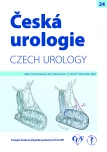Examination of circulating tumor cells in renal carcinoma
Authors:
Petr Klézl 1; Jindřich Šonský 1; Eliška Pospíšilová 2; Katarína Kološtová 2; Vladimír Bobek 2,3; Robert Grill 1
Authors‘ workplace:
Urologická klinika FN Královské Vinohrady a 3. LF UK, Praha
1; Oddělení laboratorní diagnostiky, laboratorní genetika, 3. LF UK a FN Královské Vinohrady, Praha
2; III. chirurgická klinika 1. LF UK Praha a FN Motol, Praha
3
Published in:
Ces Urol 2020; 24(2): 100-104
Category:
Review article
Zařazení vyšetření na cirkulující nádorové buňky do běžného algoritmu vyšetření u pacientů po operaci ledviny pro nádor by se mohlo stát nenahraditelným zdrojem informací vypovídajících o heterogenitě a vývoji nádoru v průběhu onemocnění. Vyšetření na přítomnost cirkulujících nádorových buněk spadá do skupiny takzvaných tekutých biopsií, jejichž neopomenutelnou výhodou je jejich minimální invazivnost při získávání vzorku (odběr periferní krve), které umožňuje sledování vývoje tumoru. Dále je možné u pacientů s cirkulujícími nádorovými buňkami podstupujících operaci pro karcinom ledviny vyšetřit molekulární charakter cirkulujících buněk zhodnocením analýzy genové exprese.
Overview
Serial examination of circulating tumor cell presence after renal cancer surgery could become an irreplaceable source of information reporting on tumor heterogeneity and evolution in time. Test for presence of circulating tumor cells belongs to the group of liquid biopsy tests and one of its main advantages is the relatively minimal invasiveness (blood withdrawal), which indeed enables tumor dynamics follow-up. Besides circulating tumor cells the presence in patients with renal cell carcinoma undergoing surgery, molecular character of circulating cells can be evaluated by gene expression analysis.
Keywords:
Renal cell carcinoma – circulating tumor cells – liquid biopsy – Gene expression – circulating tumor microemboli
Sources
1. Asworth TR. A case of cancer in which cells similar to those in tumors were seen in the blood after death. Aust Med J 1869; 14 : 146–149.
2. Lugo TG, Braun S, Cote RJ, Pantel K, Rusch V. Detection and measurement of occult disease for the prognosis of solid tumors. J Clin Oncol 2003; 21 : 2609–2615.
3. Santoni M, Cimadamore A, Cheng L, et al. Circulating Tumor Cells in Renal Cell Carcinoma: Recent Findings and Future Challenges. Front Oncol 2019; 9 : 228.
4. Zhu P, Ho T, Castle EP, et al. Detection of Circulating Tumor Cells in Renal Cell Carcinoma. San Diego: AACR, 2014.
5. Maertens Y, Humberg V, Erlmeier F, et al. Comparison of isolation platforms for detection of circulating renal cell carcinoma cells. Oncotarget 2017; 50 : 87710–87717.
6. Bilkenroth U, Taubert H, Riemann D, et al. Detection and enrichment of disseminated renal carcinoma cells from peripheral blood by immunomagnetic cell separation. Int J Cancer 2001; 92 : 577–582.
7. Meye A, Bilkenroth U, Schmidt U, et al. Isolation and enrichment of urologic tumor cells in blood samples by a semi‑automated CD45 depletion autoMACS protocol. Int J Oncol 2002; 21 : 521–530.
8. Bluemke K, Bilkenroth U, Meye A, et al. Detection of circulating tumor cells in peripheral blood of patients with renal cell carcinoma correlates with prognosis. Cancer Epidemiol Biomarkers Prev. 2009; 18 : 2190–2194.
9. Shimazui T, Yoshikawa K, Uemura H, et al. Detection of cadherin-6 mRNA by nested RT‑PCR as a potential marker for circulating cancer cells in renal cell carcinoma. Int J Oncol 2003; 23 : 1049–1054.
10. Li G, Passebosc‑Faure K, GentilPerret A, et al. Cadherin-6 gene expression in conventional renal cell carcinoma: a useful marker to detect circulating tumor cells. Anticancer Res. 2005; 25 : 377–381.
11. Buchner A, Riesenberg R, Kotter I, et al. Frequency and prognostic relevance of disseminated tumor cells in bone marrow of patients with metastatic renal cell carcinoma. Cancer 2006; 106 : 1514–1520.
12. Basso U, Facchinetti A, Rossi E, et al. Prognostic role of circulating tumor cells‑CTCs in metastatic renal cell carcinoma. J Clin Oncol. 2017; 35 : 4568–4568.
13. Krebs MG, Metcalf RL, Carter L, et al. Molecular analysis of circulating tumour cells‑biology and biomarkers. Nat Rev Clin Oncol. 2014; 11 : 129–144.
14. Palumbo JS, Talmage KE, Massari JV, et al. Platelets and fibrin(ogen) increase metastatic potential by impeding natural killer cell‑mediated elimination of tumor cells. Blood 2005; 105 : 178–185.
15. Zhang D, Zhao L, Zhou P, et al. Circulating tumor microemboli (CTM) and vimentin+ circulating tumor cells (CTCs) detected by a size‑based platform predict worse prognosis in advanced colorectal cancer patients during chemotherapy. Cancer Cell Int. 2017; 17 : 6.
16. Hou JM, Krebs MG, Lancashire L, et al. Clinical significance and molecular characteristics of circulating tumor cells and circulating tumor microemboli in patients with small‑cell lung cancer. J Clin Oncol. 2012; 30 : 525–532.
17. Nagaya N, Kanayama M, Nagata M, Horie S. The Surge in the Number of Circulating Tumor Cells Following Treatment with Sunitinib for Metastatic Renal Cell Carcinoma. Intern Med. 2018; 57(18): 2695–2700
Labels
Paediatric urologist Nephrology Urology Clinical oncologyArticle was published in
Czech Urology

2020 Issue 2
Most read in this issue
- Renal tumor biopsy – indications, technique, results
- Examination of circulating tumor cells in renal carcinoma
- Objemný cystický lymfangiom levé nadledviny – diferenciálně diagnostický omyl
- Natural healing process after partial glans excision while using novel haemostatic „VerisetTM patch“: description of the technique and initial surgeon’s perspective
